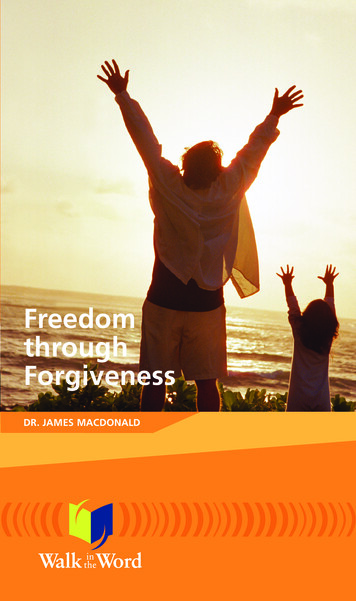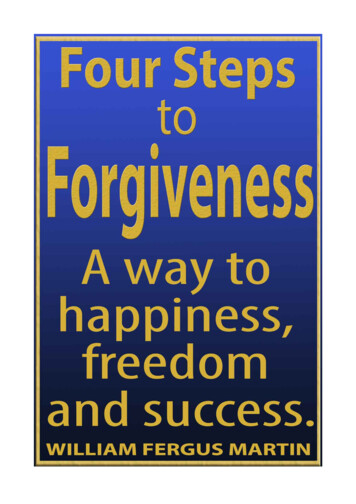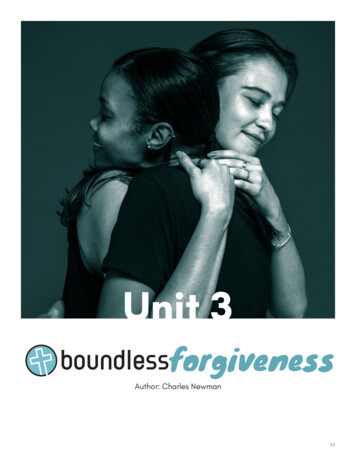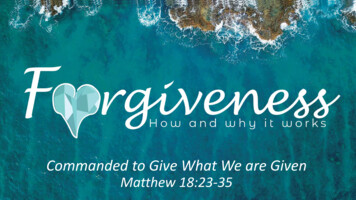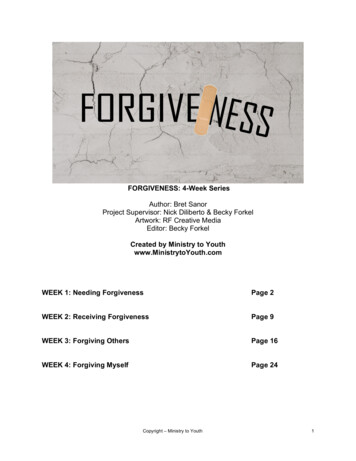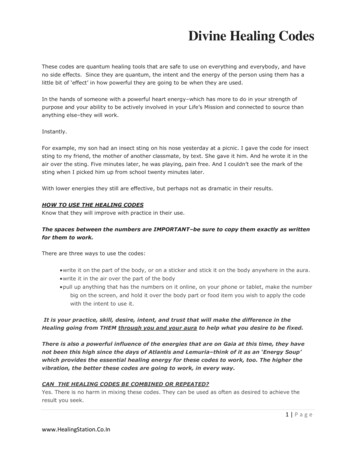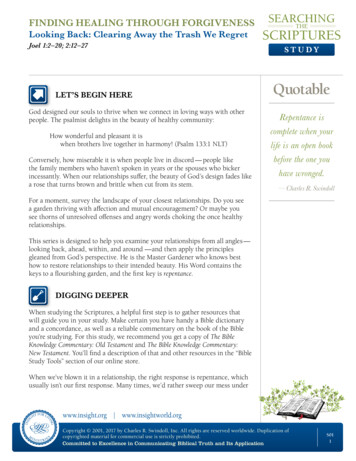
Transcription
FINDING HEALING THROUGH FORGIVENESSLooking Back: Clearing Away the Trash We RegretJoel 1:2 – 20; 2:12 – 27LET’S BEGIN HEREGod designed our souls to thrive when we connect in loving ways with otherpeople. The psalmist delights in the beauty of healthy community:How wonderful and pleasant it iswhen brothers live together in harmony! (Psalm 133:1 NLT)Conversely, how miserable it is when people live in discord — people likethe family members who haven’t spoken in years or the spouses who bickerincessantly. When our relationships suffer, the beauty of God’s design fades likea rose that turns brown and brittle when cut from its stem.ST U DYQuotableRepentance iscomplete when yourlife is an open bookbefore the one youhave wronged.— Charles R. SwindollFor a moment, survey the landscape of your closest relationships. Do you seea garden thriving with affection and mutual encouragement? Or maybe yousee thorns of unresolved offenses and angry words choking the once healthyrelationships.This series is designed to help you examine your relationships from all angles —looking back, ahead, within, and around — and then apply the principlesgleaned from God’s perspective. He is the Master Gardener who knows besthow to restore relationships to their intended beauty. His Word contains thekeys to a flourishing garden, and the first key is repentance.DIGGING DEEPERWhen studying the Scriptures, a helpful first step is to gather resources thatwill guide you in your study. Make certain you have handy a Bible dictionaryand a concordance, as well as a reliable commentary on the book of the Bibleyou’re studying. For this study, we recommend you get a copy of The BibleKnowledge Commentary: Old Testament and The Bible Knowledge Commentary:New Testament. You’ll find a description of that and other resources in the “BibleStudy Tools” section of our online store.When we’ve blown it in a relationship, the right response is repentance, whichusually isn’t our first response. Many times, we’d rather sweep our mess underwww.insight.org www.insightworld.orgCopyright 2001, 2017 by Charles R. Swindoll, Inc. All rights are reserved worldwide. Duplication ofcopyrighted material for commercial use is strictly prohibited.Committed to Excellence in Communicating Biblical Truth and Its ApplicationS011
FINDING HEALING THROUGH FORGIVENESSLooking Back: Clearing Away the Trash We RegretJoel 1:2 – 20; 2:12 – 27ST U DYthe rug or blame our trash on someone else. To repent we must deal with our sin honestly and be willing tobear the pain of regret and guilt — like David did when he dug through the debris of his past sins.Searching the Scriptures Study ToolTo clarify a biblical concept, such as repentance, a helpful study tool is to see it modeled in Scripture andthen draw principles from the person’s example. David’s repentance is on display in Psalm 31:9 –16. Readthese verses, and note some of the characteristics of true repentance.From David’s example, what feelings are associated with repentance (Psalm 31:9 –10)?David took ownership of his sin, “my iniquity” (31:10 NASB). What characteristic of repentance can youdraw from his example?What consequences did David endure (31:11 – 13)?Finally, to whom does a repentant person turn for help (31:14 – 16)?www.insight.org www.insightworld.orgCopyright 2001, 2017 by Charles R. Swindoll, Inc. All rights are reserved worldwide. Duplication ofcopyrighted material for commercial use is strictly prohibited.Committed to Excellence in Communicating Biblical Truth and Its ApplicationS012
FINDING HEALING THROUGH FORGIVENESSLooking Back: Clearing Away the Trash We RegretJoel 1:2 – 20; 2:12 – 27ST U DYConsolidate these points in a description of true repentance. From David’s example, repentance involves . . .David didn’t move on with his life hoping his sins would be forgotten; he stopped. He looked back. Headmitted his wrongs. And he took responsibility for the trash that littered the roadside — the splintered trust,dashed promises, and rotting pile of problems that his sin caused. Most important, rather than hide from theLord as did Adam and Eve in their shame and regret, he drew close to the Lord to receive mercy.Our acts of repentance — confessing our sin, taking responsibility for the consequences, and drawingnear to God for mercy — please the Lord with the sweet aroma of heartfelt sacrifice (Psalm 51:16 – 17). TheLord longs for our repentance because He longs for a closer relationship with us. The process of confession,forgiveness, and restoration deepens our devotion to Him and bonds us with others like nothing else can.Shame separates us, but repentance connects and restores.So vital is repentance to the health of our soul and our relationships that the Lord will do whatever it takesto produce its fruit — as He did to the nation of Judah in the days of the prophet Joel.A Divinely Designed DisasterCalamity struck the farming culture of Judah in three waves of natural disasters. Can you identify them inJoel 1:5 – 7, 12, and 19 – 20?These disasters were devastating, but the most destructive was the locust plague that stripped the spirit ofthe people as bare as the landscape, leaving them in complete ruin. Write down the descriptions of locustsin Joel 1:4, and then note the catastrophic impact to the food source in Joel 1:10, 16 –18.www.insight.org www.insightworld.orgCopyright 2001, 2017 by Charles R. Swindoll, Inc. All rights are reserved worldwide. Duplication ofcopyrighted material for commercial use is strictly prohibited.Committed to Excellence in Communicating Biblical Truth and Its ApplicationS013
FINDING HEALING THROUGH FORGIVENESSLooking Back: Clearing Away the Trash We RegretJoel 1:2 – 20; 2:12 – 27ST U DYFurther StudyFor an explanation of the shocking effects of a locust swarm, read the description under the heading“Locust” in the Animal Kingdom article in The New Unger’s Bible Dictionary. A copy of this classicBible study resource can be obtained at the Insight for Living Ministries Web store. What strikes youabout the devastation of a locust plague?In chapter 2, Joel compares the locust swarm to an army of soldiers who “leap along the mountaintops”( Joel 2:5 NLT) and “break through defenses without missing a step” (2:8). As they charge, “the sun andmoon grow dark, and the stars no longer shine” (2:10). It’s an apocalyptic scene, and who is leading theadvance?The Lord is at the head of the column.He leads them with a shout.This is his mighty army,And they follow his orders.The day of the Lord1 is an awesome, terrible thing.Who can possibly survive? (2:11)Why was the Lord’s discipline so severe? What does the extent of the discipline say about the severity of thepeople’s sin?Only a heavy battering ram could break through the defenses of the people’s stubborn will. God’s purpose,however, was not to destroy but to call His people to repentance and set them on a new path of restoration.www.insight.org www.insightworld.orgCopyright 2001, 2017 by Charles R. Swindoll, Inc. All rights are reserved worldwide. Duplication ofcopyrighted material for commercial use is strictly prohibited.Committed to Excellence in Communicating Biblical Truth and Its ApplicationS014
FINDING HEALING THROUGH FORGIVENESSLooking Back: Clearing Away the Trash We RegretJoel 1:2 – 20; 2:12 – 27ST U DYThree Principles of RestorationAfter God’s judgments comes the hope of restoration, which descends like refreshing showers on a parchedlandscape. What blessings does Joel describe in 2:23 – 24, culminating with this wonderful promise: “TheLord says, ‘I will give you back what you lost to the swarming locusts’” ( Joel 2:25)?Have the locust-like consequences of sin stripped some of your relationships to barren stalks of terse, bitterexchanges? God can breathe new life into these damaged relationships as you apply three principles fromJudah’s example.Start Immediately without RationalizationRead Joel 2:12, and notice that the Lord urged the people to repent right away and be genuine: “Don’t tearyour clothing in your grief, but tear your hearts instead” (Joel 2:13).Don’t put off your repentance, and don’t rationalize the wrong. Get specific in your confession. Have youbeen selfish, stubborn, prideful? Has a demanding tone laced your words? Have you been more willing topoint blame than show grace? List the sins and how they’ve harmed others.Return Completely without ReservationReread Joel 2:13 for the second principle. God’s complete mercy is available in exchange for completerepentance. As Chuck says:No hidden clauses. No inner reservations. No closed doors. No carefully kept secrets.Repentance is incomplete when there are areas that are held back or protected or leftunaddressed and unaccountable. Repentance is complete when your life is an open bookbefore the one you have wronged.www.insight.org www.insightworld.orgCopyright 2001, 2017 by Charles R. Swindoll, Inc. All rights are reserved worldwide. Duplication ofcopyrighted material for commercial use is strictly prohibited.Committed to Excellence in Communicating Biblical Truth and Its ApplicationS015
FINDING HEALING THROUGH FORGIVENESSLooking Back: Clearing Away the Trash We RegretJoel 1:2 – 20; 2:12 – 27ST U DYOpening your heart and life to the one you’ve offended often begins with a frank conversation with a trustedconfidant. Whom can you talk to about your secrets, and when can you schedule a meeting?Repent Openly without HesitationThe urgency of repentance rings like a freedom bell in Joel 2:14 – 17. Read these verses, and write down theexpressions of repentance. What do you learn from Judah’s openness to guide your repentance process?Bring It HomeSpecifically, resolving offenses in our relationships includes this process: Sit down with the individual or individuals you’ve injured because of your behavior, and workthrough the list of wrongs one by one. Confess your sin and own the consequences. Describe your new course of change and accountability. Ask the person to forgive you.Granting forgiveness may take time . . . which Chuck discusses in his next message. For now, we’ve doneour part to clear away the trash and sow seeds of repentance in anticipation of a beautiful garden!www.insight.org www.insightworld.orgCopyright 2001, 2017 by Charles R. Swindoll, Inc. All rights are reserved worldwide. Duplication ofcopyrighted material for commercial use is strictly prohibited.Committed to Excellence in Communicating Biblical Truth and Its ApplicationS016
FINDING HEALING THROUGH FORGIVENESSLooking Back: Clearing Away the Trash We RegretJoel 1:2 – 20; 2:12 – 27ST U DYClose this study by writing a prayer asking the Lord for His forgiveness and receiving His grace, for He is“merciful and compassionate, slow to get angry and filled with unfailing love” ( Joel 2:13).A FINAL PRAYERFather, I will not rationalize my sin but ask Your Spirit to do a work in my heart, to restore joy in my home,and to rebuild broken relationships. Give me the integrity and courage to come to terms with the things thatrequire attention. May good come from my repentance. Relief. Freedom. Deliverance. And the free flow ofpeace. Amen.ENDNOTE1.Joel’s theme of “the day of the Lord” echoes through the canyons of prophetic literature in various forms until its complete expressionwhen Christ returns in judgment at His second advent (Revelation 19:11 – 20:15).www.insight.org www.insightworld.orgCopyright 2001, 2017 by Charles R. Swindoll, Inc. All rights are reserved worldwide. Duplication ofcopyrighted material for commercial use is strictly prohibited.Committed to Excellence in Communicating Biblical Truth and Its ApplicationS017
FINDING HEALING THROUGH FORGIVENESSLooking Back: Finding Healing through Forgivenesswith Cynthia Swindoll’s TestimonyMatthew 5:23–24; 18:21–35LET’S BEGIN HEREIn the school of life, all of us must take a course on forgiveness. No one has theoption to bypass this class, because we all need to forgive someone or to seekforgiveness from someone we’ve offended. The only student who might optout of Forgiveness 101 is the one who has never hurt anyone or been hurt byanyone — and because that person doesn’t exist, everyone must enroll!Our teacher is the world’s leading expert on forgiveness. No one has moreexperience in forgiving than Him. His exams can be tough when we’re askedto put into practice what we’ve learned; however, when we pass the test, thefeeling of relief that follows is healing to the soul.Let’s join our teacher, Jesus, on the hillside by the Sea of Galilee where He isstarting His first lecture on the topic of seeking forgiveness.ST U DYQuotableThere are not manythings that we allhave in common,but I can tell youone: we all havesomeone we needto forgive.— Charles R. SwindollDIGGING DEEPER“So if you are presenting a sacrifice at the altar in the Templeand you suddenly remember that someone has somethingagainst you, leave your sacrifice there at the altar. Go and bereconciled to that person. Then come and offer your sacrificeto God.” (Matthew 5:23–24 NLT)Seeking Forgiveness from Those We’ve OffendedThis teaching comes from Jesus’ Sermon on the Mount (Matthew 5–7). For theimmediate context, read Matthew 5:21–22, in which the subject is relationshipconflict. What infractions did Jesus say were just as much a violation of God’slaw as murder?www.insight.org www.insightworld.orgCopyright 2002, 2017 by Charles R. Swindoll, Inc. All rights are reserved worldwide. Duplication ofcopyrighted material for commercial use is strictly prohibited.Committed to Excellence in Communicating Biblical Truth and Its ApplicationS021
FINDING HEALING THROUGH FORGIVENESSLooking Back: Finding Healing through Forgivenesswith Cynthia Swindoll’s TestimonyMatthew 5:23–24; 18:21–35ST U DYFriction between individuals may smolder as resentment or flame up as anger, spark as name-calling orignite as out-of-control rage. Regardless the degree of heat, Jesus said the fire must be doused immediately,both in our heart where sin begins and with our feet as we rush to make amends.Searching the Scriptures Study ToolLet’s study Matthew 5:23 – 24 using our Searching the Scriptures skills of observation, interpretation,correlation, and application. Imagine yourself as the person making an offering at the temple. List the actionwords that you observe in Jesus’ teaching.Next is interpretation. What is the meaning of Jesus’ teaching regarding (1) the priority of reconcilingwith people before reconciling with God; (2) the urgency of not waiting; and (3) the importance of takingresponsibility for an offense?Go a little deeper into interpretation by using a concordance to explore the meaning of the Greek word for“be reconciled.” First, look up the word reconciled in the Zondervan NASB Exhaustive Concordance. BesideMatthew 5:24, you’ll find the number 1259, which is the key to the Greek word. Look up this number in theback of the concordance to find the root Greek word diallasso and its meaning “change, exchange” and thenumber of times the word occurs in the New Testament.1 Interestingly, it appears only once — here, in thisverse.Now use the online tool, Lumina, at lumina.bible.org. Locate Matthew 5:24 in the NASB, then click “Greek”on the right panel. Slowly move your cursor over the words in the Greek text of this verse. An explanationof each word appears below in a box. Find the Greek word for be reconciled and its definition, which is “1) tochange 2) to change the mind of anyone, to reconcile 3) to be reconciled, to renew friendship with one.”www.insight.org www.insightworld.orgCopyright 2002, 2017 by Charles R. Swindoll, Inc. All rights are reserved worldwide. Duplication ofcopyrighted material for commercial use is strictly prohibited.Committed to Excellence in Communicating Biblical Truth and Its ApplicationS022
FINDING HEALING THROUGH FORGIVENESSLooking Back: Finding Healing through Forgivenesswith Cynthia Swindoll’s TestimonyMatthew 5:23–24; 18:21–35ST U DYFascinating! Reconciliation includes change. Chuck Swindoll offers his explanation of being reconciled: “togo through the process of bringing about a change [in the relationship].” Hostility changes to friendship.Based on your study, how would you explain diallasso ? How does this meaning enhance your understandingof Jesus’ command?Now, correlation. Paul applies the concept of reconciliation to our relationship with God in2 Corinthians 5:18–21. Read these verses in comparison with Jesus’ teaching on reconciliation. Both are inthe passive voice, “be reconciled.” We seek forgiveness, but reconciliation requires a response from the otherparty. Reconciliation must be received to be complete. Although we seek reconciliation, a person may rebuffour diallasso attempt. God, however, will always welcome us with open arms.Through Christ, we can be certain of our reconciliation with God. How does this security stabilize you asyou seek reconciliation with others who may not be as willing or able to forgive?Finally, application. Are you in conflict with anyone? Is God leading you to seek reconciliation? Listen toCynthia Swindoll’s testimony, and note the steps that she took when seeking reconciliation with her fatherand mother-in-law. How can her actions be a guide for you?Forgiving Those Who’ve Offended UsJesus’ next lesson, offering forgiveness, is prompted by Peter’s question about the frequency of forgiving:“Lord, how often should I forgive someone who sins against me? Seven times?” (Matthew 18:21). Jesus’answer shocked Peter, “‘No, not seven times,’ Jesus replied, ‘but seventy times seven!’” (18:22).www.insight.org www.insightworld.orgCopyright 2002, 2017 by Charles R. Swindoll, Inc. All rights are reserved worldwide. Duplication ofcopyrighted material for commercial use is strictly prohibited.Committed to Excellence in Communicating Biblical Truth and Its ApplicationS023
FINDING HEALING THROUGH FORGIVENESSLooking Back: Finding Healing through Forgivenesswith Cynthia Swindoll’s TestimonyMatthew 5:23–24; 18:21–35ST U DYPeter viewed forgiveness through the narrow lens of human limitations. Figuring that our capacity to forgiveruns out sooner or later, he sought permission to limit forgiving to no more than seven times.Jesus, however, broke down all limitations! Rather than restrict forgiving to a certain number, he set us freeto forgive anytime in any relationship. For Jesus, the issue wasn’t frequency but freedom, and the measurewasn’t a human standard but the limitless grace of God — as illustrated in the following story, whichcontains three parts.First, read Matthew 18:23–27 about the king’s forgiveness of the servant’s tremendous debt — “millionsof dollars” (Matthew 18:24 NLT). Second, read Matthew 18:28–30 about the servant’s lack of forgivenesstoward his companion and his small debt. Third, read Matthew 18:31–35 about the king’s response when hefinds out.2What does the magnitude of the debt forgiven say about the heart of the king who forgave it? Likewise, whatdoes the small debt that the servant refused to forgive say about his heart?Summarize Jesus’ point about forgiving.Bring It HomeLet’s wrap up Jesus’ teaching on forgiveness with two principles on asking for forgiveness: Immediate obedience honors God. Jesus said plainly, “Go and be reconciled” (Matthew 5:24). Vulnerable confession heals others. Sincere apologies soften those we’ve offended and restore brokenrelationships.www.insight.org www.insightworld.orgCopyright 2002, 2017 by Charles R. Swindoll, Inc. All rights are reserved worldwide. Duplication ofcopyrighted material for commercial use is strictly prohibited.Committed to Excellence in Communicating Biblical Truth and Its ApplicationS024
FINDING HEALING THROUGH FORGIVENESSLooking Back: Finding Healing through Forgivenesswith Cynthia Swindoll’s TestimonyMatthew 5:23–24; 18:21–35ST U DYAnd two principles on forgiving those who have offended us: To refuse to forgive is hypocritical. How can we not forgive the sins of others when our King has freelyforgiven us? To refuse to forgive inflicts inner torment on the offended. A lack of forgiveness makes our bad situationworse; it multiplies the pain of the offense with the torment of bitterness.Let’s close this study by drawing near to our teacher Jesus. If you need to reconcile a relationship, ask Jesusfor the courage to seek forgiveness. Or if someone has injured you, ask the Lord for the grace to extendforgiveness.A FINAL PRAYERFather, sleepless nights and restless days are the plight of the tortured soul that will not forgive. I submit myselfto the authority of Your Word that marks the path to healing. Help me to seek forgiveness from those I’veoffended. Help me to forgive, even as I have been forgiven by Christ. Amen.ENDNOTES1.2.Reuben A. Olson, and others, eds., Zondervan NASB Exhaustive Concordance (Grand Rapids: Zondervan, 1998), 1520.What does “handed him over to the torturers” mean (Matthew 18:34 NASB)? Chuck explains it as the torment of unforgiveness: “It isan accurate description of gnawing resentment and bitterness. The awful gall of hate or envy. It is a terrible feeling. We cannot get awayfrom it.”www.insight.org www.insightworld.orgCopyright 2002, 2017 by Charles R. Swindoll, Inc. All rights are reserved worldwide. Duplication ofcopyrighted material for commercial use is strictly prohibited.Committed to Excellence in Communicating Biblical Truth and Its ApplicationS025
FINDING HEALING THROUGH FORGIVENESSLooking Back: Finding Healing through Forgivenesswith Cynthia Swindoll’s TestimonyMatthew 5:23–24; 18:21–35ST U DYTools for Digging DeeperFinding Healing throughForgivenessGuilt, Grace, andGratitudeby Charles R. Swindoll2-CD setby Charles R. Swindoll andInsight for Living Ministries2-CD setPerfect Trustby Charles R. Swindollhardback bookFor these and related resources, visit www.insightworld.org/storeor call USA 1-800-772-8888 AUSTRALIA 61 3 9762 6613 CANADA 1-800-663-7639 UK 44 1306 640156For the 2017 broadcast, this Searching the Scriptures study was developed by the Pastoral Ministries Department in collaboration withMark Tobey, based upon the original outlines, charts, and sermon transcripts of Charles R. Swindoll’s messages.www.insight.org www.insightworld.orgCopyright 2002, 2017 by Charles R. Swindoll, Inc. All rights are reserved worldwide. Duplication ofcopyrighted material for commercial use is strictly prohibited.Committed to Excellence in Communicating Biblical Truth and Its ApplicationS026
Only a heavy battering ram could break through the defenses of the people's stubborn will. God's purpose, however, was not to destroy but to call His people to repentance and set them on a new path of restoration. FINDING HEALING THROUGH FORGIVENESS Looking Back: Clearing Away the Trash We Regret o2el J1: 201; 22: 27 STUDY




